Hot pot
Hot pot or hotpot (simplified Chinese: 火锅; traditional Chinese: 火鍋; pinyin: huǒguō; lit.: 'fire pot'), also known as soup-food or steamboat, is a Chinese cooking method, prepared with a simmering pot of soup stock at the dining table, containing a variety of East Asian foodstuffs and ingredients.
A common hotpot setup: raw foods ready to be cooked, with hot broth at the center of the table | |
| Course | Main dishes |
|---|---|
| Place of origin | China |
| Region or state | East Asia |
| Main ingredients | Meat, leaf vegetables, mushrooms, dumplings, and seafood |
| Hot pot | |||||||||||||||||
|---|---|---|---|---|---|---|---|---|---|---|---|---|---|---|---|---|---|
| Traditional Chinese | 火鍋 | ||||||||||||||||
| Simplified Chinese | 火锅 | ||||||||||||||||
| Literal meaning | "fire pot" | ||||||||||||||||
| |||||||||||||||||
| Cantonese name | |||||||||||||||||
| Traditional Chinese | 打邊爐 or 打甂爐 | ||||||||||||||||
| Simplified Chinese | 打边炉 or 打甂炉 | ||||||||||||||||
| |||||||||||||||||
Description
While a hot pot full of flavored broth is kept simmering, raw ingredients are placed into the pot and are cooked in a manner similar to fondue (hot pots usually use a water-based soup, while fondues use cooking oil). Hot pots may be prepared and eaten either at home or in a restaurant. Since it is considered as a main dish, it can be enjoyed without other separate courses like rice or noodles. The cooked food is often eaten with a dipping sauce for additional flavoring.
Typical hot pot ingredients include thinly sliced meat, leaf vegetables, mushrooms, vermicelli, sliced potatoes, bean products, egg dumplings, tofu, and seafood. Raw ingredients are pre-sliced into thin sections that will cook quickly and consistently in the simmering broth, which is maintained at a gentle boiling temperature. Most raw foods can be cooked in a hot pot, although they may have different cooking times, and must be immersed in the soup and then removed accordingly.

At the conclusion of the meal, the broth has acquired many flavors from the added ingredients, and may be served to the diners after turning off the cooking heat source.
History
Archaeological evidence shows that the earliest hot pots appeared around the Zhou dynasty. The tripods of Zhou dynasty may be the earliest prototypes of the hot pot. Diners among the nobility each had a personal pot made of bronze, and called ran lu (燃炉). The main part of ran lu was a small stove with a small pot above burning charcoal. Later, during the Qing dynasty, hot pot became popular among the emperors. In particular, the Qianlong Emperor was very fond of hot pot, and would eat it for almost every meal. Later, the Jiaqing Emperor also had a banquet with 1,550 hot pots at his coronation. Empress Dowager Cixi was also known to have enjoyed hot pot, especially in the winter months.[1]
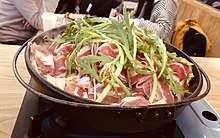
Popularity
Hot pot meals can enhance friendship and unite family members or colleagues as several people sit around a pot, talking and eating. The warm atmosphere makes people feel comfortable and relaxed.[2] Hot pot is especially popular in winter and cold places.
Due to the high popularity and the unique way of eating, hot pot has already become the major attraction of the tourism industry in some areas, such as Chongqing and Sichuan. There are so many hot pot restaurants people can choose and taste. The growing popularity of hot pot not only brings huge economic profits to related industries and itself but also leads to strong competition. Therefore, more and more hot pot restaurants improve their service quality and dining environment to attract the consumers. [3]
How to eat
Choose the soup base
There are a variety of broths people can choose, such as spicy soup base with beef oil or vegetable oil, wild mushroom soup base, tomato soup base, and tom yum kung soup base. People can select up to three soup bases in a divided pot in some restaurants.
Distinguish the ingredients
The most important thing is to distinguish different kinds of raw materials to ensure the delicious taste. Some ingredients should be cooked for only a few seconds, such as duck intestines, goose intestines, and beef tripe. Some ingredients need to be cooked for several minutes, such as meat balls, mushrooms, pork brain, and duck blood.
Make your own dipping sauce
There is usually a sauce station in the hot pot restaurant which provides different kinds of sauces. People can make their own dipping sauce based on their choices and tastes.
Eating order
After the soup is fully boiled, people can put ingredients into the pot. The best order of eating hot pot is to eat meat first, then vegetables.[4]
Common ingredients
- Basic stock is often made using:
- Meats and protein vary, and can include:
- Thinly sliced lamb, goat, beef, sometimes pork, chicken or other poultry
- Pork brain
- Fish
- Prawns
- Scallops
- Cockles
- Clams
- Mussels
- Beef tripe
- Beef tongue
- Beef aorta
- Duck intestines
- Goose intestines
- duck blood
- Beef balls
- Fish balls
- Shrimp balls
- Shrimp paste
- Fish slices
- Offal, especially beef tripes
- Blood tofu
- Squid
- Crab
- Lobster
- Crawfish
- Octopus
- Geoduck
- Cuttlefish
- Sea cucumber
- Tofu, Tofu skin, Fu zhu, Japanese style fish tofu, frozen tofu or fried tofu
- Egg dumplings (蛋饺)
- Kamaboko and crab stick
- Mantis shrimp
- Beef tongue
- Quail eggs
- Chicken feet
- Ribs
- Starches include:
- Glass noodle
- Chinese noodles
- Udon
- Niangao
- Vegetables such as:
- Bok choy
- Napa cabbage
- Crown daisy
- Spinach
- Lettuce
- Carrots
- Winter melon
- Bean sprouts
- Daikon
- Potatoes and Sweet Potatoes
- Varieties of mushrooms, straw mushroom, enoki mushrooms (金针菇), Shiitake (香菇), oyster mushrooms, etc
- Taro
- Pumpkin
- Watercress
- Haidai (Seaweed)
- Cilantro
- Condiments:
- Sesame butter
- Hoisin sauce
- Soy sauce
- Vinegar (white or black)
- Cilantro
- Minced Garlic
- Scallion
- Sesame oil
- Shacha sauce
- Chili oil
- Chive flower paste (韭菜花酱)
- Fermented bean curd (腐乳)
- White pepper
- XO sauce
- Douchi
Regional variations
East Asia
Mainland China
.jpg)
Different kinds of hot pots can be found in Chongqing and Sichuan; typically, more modern eateries offer a partitioned pot with differently-flavored broths in each section. More traditional or older establishments often serve a fragrant, mild broth in a large brass vessel heated by burning coals in a central chimney. The broth is simmered in a deep, donut-shaped bowl surrounding the chimney.
One of the most famous variations is the Chongqing hot pot (Chinese: 麻辣; pinyin: má là; lit.: 'numb and spicy'), to which Sichuan pepper (Chinese: 花椒; pinyin: huā jiāo; lit.: 'flower pepper'; also known as "prickly ash") is added. It is usual to use a variety of different meats as well as sliced mutton fillet. A Chongqing hotpot is markedly different from the types eaten in other parts of China. Quite often the differences lie in the meats used, the type of soup base, and the sauces and condiments used to flavor the meat. The typical dipping sauce contains sesame oil and is mixed with crushed fresh garlic and chopped spring onions. Due to the high humidity in the region, local people eat spicy food to remove the moisture from their bodies.[5]
Chongqing hot pot(Chinese: 麻辣; pinyin: má là; lit.: 'numb and spicy') is the representative of "northern style hot pot", which is famous for the spicy taste.[6] Instant-boiled mutton (Chinese: 涮羊肉; pinyin: Shuàn Yángròu) could be viewed as representative of "northern style hot pot", which focus on the main ingredients rather than the soup base.[7]
Sichuan also has a number of dry hot pots such as Mala Xiang Guo (Chinese: 麻辣香锅; lit.: 'tasty spicy pot') are similar to those described above, but lack the soup base. It originated in Chongqing, China. Mala Xiang Guo is popular because it is a convenient cooking method suitable for almost all kinds of ingredients. [8]
In neighbouring Yunnan, although spicy broths are equally popular, there is another predominant type of hot pot that is made with various wild or farmed mushrooms. It is called the Wild Mushroom hot pot (Chinese: 野生菌火锅). Due to the vast forests and abundant natural resources in Yunnan, people can find a wide variety of edible mushrooms. The easily accessible and fresh mushroom resources lead to the high popularity of the Wild Mushroom hot pot. [9]The big difference between the mushroom hot pot and the spicy hot pot is that the former omits strong spice and chili, and the latter preserves the original flavor of the mushrooms. The mushroom hot pot is also seasonal, depending on the availability of local mushrooms.
The Manchu hot pot (Chinese: 東北酸菜火鍋) uses plenty of suan cai (Chinese sauerkraut) (Chinese: 酸菜; pinyin: suān cài) to make the broth sour.
A Cantonese variation includes mixing a raw egg with the condiments to reduce the amount of "heat" absorbed by the food, thereby reducing the likelihood of a sore throat after the steamboat meal, according to Chinese herbalist theories.
In Hubei cuisine, hot pot is normally prepared with hot spices and Sichuan pepper. Items supplied to be cooked in this broth include mushrooms, thinly-shaved beef or lamb, lettuce, and various other green vegetables.
In Hainan cuisine hot pot is generally served in small woks with a prepared broth containing pieces of meat. At the time of serving, the meat is not fully cooked, and approximately fifteen minutes are required before it is ready to eat. Items supplied to be cooked in this type of hot pot include mushrooms, thinly-shaved beef or goat meat (sometimes mistakenly referred to as "mutton"), lettuce, and other green vegetables. This dish varies somewhat in different parts of the province. Coconut milk and juice is commonly added into the hot pot.
In Jiangsu and Zhejiang cuisine, chrysanthemum flowers are cooked in the broth to give it a floral essence.
Taiwan
In Taiwanese cuisine, hot pot (usually called 火鍋 in Mandarin) is also called shabu-shabu (涮涮鍋) when the food is prepared in Japanese style. It is very common to eat the food with a dipping sauce consisting of shacha sauce and raw egg yolk.
Japan
In Japanese cuisine, hot pot dishes are called nabemono. There are dozens of varieties of hot pots, and each hot pot has a distinct flavor and style.
Sukiyaki is one of the most popular hot pot dishes among the Japanese, and the most well-known Japanese hot pot overseas, particularly in English-speaking parts of the world. Sukiyaki hot pot is served with sliced beef, vegetables, and tofu in a sweet sauce based on soy sauce, used sparingly, enough for the ingredients to merge in a shallow iron pot. Before being eaten, the ingredients are usually dipped in a small bowl of raw, beaten eggs.
Shabu-shabu is another popular hot pot in Japan. Shabu-shabu hot pot is prepared by submerging a very thin slice of meat or a piece of vegetable in a pot of broth made with kelp (kombu), and swishing it back and forth several times. The familiar swishing sound is where the dish gets its name. Shabu-shabu directly translates to "swish swish". Cooked meat and vegetables are usually dipped in ponzu or goma (sesame seed) sauce before eating. Once the meat and vegetables have been eaten, leftover broth from the pot is customarily combined with the remaining rice, and the resulting soup is usually eaten last.
Because the shabu-shabu hot pot is briefly used to cook beef "blue rare" to rare, use of high-grade Japanese beef is preferred. Typically, shabu-shabu is considered a fine dining dish due to the high quality of the meat used, and the corresponding price charged for it at restaurants in Japan.
With both sukiyaki and shabu-shabu, rice or noodle is cooked with the remaining broth along with additional ingredients at the very end of the meal. This is called shime, marking the end of the meal. Traditionally, hot pots are considered fall and winter dishes.
Southeast Asia
Cambodia
In Cambodian cuisine, hot pot is called yao hon (យ៉ាវហន), though some regions call it chhnang pleurng (ឆ្នាំងភ្លើង), which literally translates to "pot fire". It is usually eaten during celebrations or family gatherings. Just like the Chinese version, Cambodian hot pot consist of similar ingredients although the dish differs in that coconut milk is used as the base of the soup. Another variation of the dish is called "buttered yao hon" or "buttered chhnang pleurng"; the same ingredients are used but are instead cooked on a flat grill pan where butter is used as the base (this is similar to Korean barbecue). An herb sauce is usually added to "buttered yao hon", since the ingredients are not flavored by immersion in a broth.[10]
Philippines
In Philippine cuisine, hotpot is commonly served by Chinese specialty restaurants yet it is also not uncommon for it to offered in all-you-can-eat buffets. The terms shabu-shabu and "hotpot" are also used interchangeably for this style of food preparation.[11] In Cebu City, a specialty restaurant offers a "hot pot" that is literally a huge ceramic pot filled with cooked rice, choice of beef, pork, or chicken slices, special sauce, and choice vegetables such as broccoli, carrot, shallot, ginger, pechay, kangkong leaves, spices, and some slices of hard-boiled eggs on top; it is more similar to kamameshi than the namesake.
Thailand
In Thai cuisine, hotpot is called Thai suki, although it is quite different from the Japanese shabu-shabu variation called sukiyaki. Originally a Chinese-style hot pot, the number of ingredients to choose from was greatly increased and a Thai-style dipping sauce with chili sauce, chilli, lime, and coriander leaves was added. Another variation is mu kratha, the Thai hot pot which originated from Korean barbecue combined with Thai suki. In the Northeast region, a similar style of cooking called chim chum where thinly sliced meat is cooked in clay pots on charcoal stove is also popular.
Vietnam
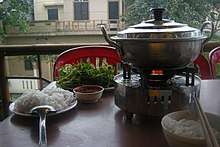
In Vietnamese cuisine, a hot pot is called lẩu or cù lao. There are many styles of lẩu ranging from seafood lẩu hải sản, canh chua soup-base (lẩu canh chua) or salted fish hot pot (lẩu mắm).
Related dishes
- Instant-boiled mutton
- Jjigae Jeongol - Korea
- Nabemono - Japan
- Yao Hon (យ៉ាវហន) or Chhnang Pleurng (ឆ្នាំងភ្លើង) - Cambodia
- Buttered Chhnang Pleurng
- Thai suki
- Mu kratha – also called "Thai hot pot" or mookata
- Clay pot cooking – referred to as "hot pot" or "hotpot" on Chinese restaurant menus in English-speaking regions
- Lancashire hotpot – a dish referred to as "hot pot" (or "hotpot") in Britain
- Stew
- Yong tau foo
- Fondue Bourguignonne and Fondue chinoise
Gallery
.jpg) A hot pot with various ingredients cooking
A hot pot with various ingredients cooking Spicy hot pot broth in Chongqing style.
Spicy hot pot broth in Chongqing style. A Yin-Yang hotpot with both spicy and non-spicy broths
A Yin-Yang hotpot with both spicy and non-spicy broths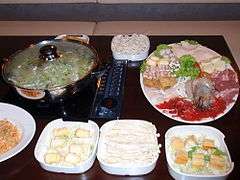 Steamboat with raw ingredients
Steamboat with raw ingredients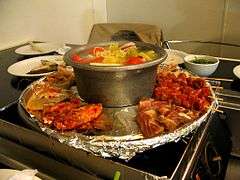 Combination of hot-pot and barbecue
Combination of hot-pot and barbecue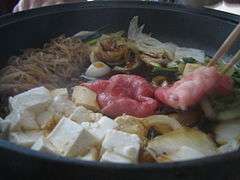 Sukiyaki ingredients ready for cooking
Sukiyaki ingredients ready for cooking_%E6%BD%AE%E5%B7%9E%E7%81%AB%E9%8D%8B%EF%BC%88%E5%9C%A8%E5%8A%A0%E5%88%A9%E7%A6%8F%E5%B0%BC%E4%BA%9E%E5%85%8B%E6%B4%9B%E7%B6%AD%E6%96%AF%E5%B8%82%E8%A3%BD%E5%82%99%EF%BC%89.jpg) Teochew-style hotpot
Teochew-style hotpot
See also
References
- "火锅为什么如此受欢迎?这背后不可不知的故事_美食". www.sohu.com. 2018-10-25. Retrieved 2018-11-23.
- "重庆火锅为什么这么受欢迎_搜狗指南". zhinan.sogou.com. Retrieved 2018-11-23.
- "火锅产业:万亿餐饮赛道,龙头成长加速". baijiahao.baidu.com. 30 March 2020. Retrieved 27 April 2020.
- "Hot Pot". baike.baidu.com. Retrieved April 24, 2020.
- "The Significant Visual Symbols Design, Logo Design Study of Chong Qing Hot Pot Brand"
- "Hot Pot". baike.baidu.com. Retrieved 27 April 2020.
- "记住,老北京涮肉≠火锅". baijiahao.baidu.com. 24 April 2020. Retrieved 27 April 2020.
- "Mala Xiang Guo". baike.baidu.com. Retrieved 26 April 2020.
- "吃货们,你试过云南独特的野生菌火锅了吗?". baijiahao.baidu.com. 24 January 2020. Retrieved 26 April 2020.
- Srey, Kim. "Mami-Eggroll: "Yow Hon" for Two". mami-eggroll.com.
- "Make your own sauces for your hot pot indulgence". 2015-09-23.
Further reading
- Klein, E.F.; Graves, S.A. (February 1974). "'Hot Pot' Tracheitis". Chest. 65 (2): 225–226. doi:10.1378/chest.65.2.225. PMID 4521026.
- Guo, Qiaozhen; Zhang, Jing; Zhao, Shan; Shao, Bing (26 July 2012). "Determination of Five Alkaloids of Pericarpium Papaveris in Hot Pot Broth Using Ultra-Performance Liquid Chromatography Coupled to Triple Quadruple Mass Spectrometry". Food Analytical Methods. 6 (2): 698–704. doi:10.1007/s12161-012-9479-2.
- Newman, Jacqueline M. (May 2009). "China's Dongbei Cuisine". Gastronomica. 9 (2): 82–86. doi:10.1525/gfc.2009.9.2.82.
- Oum, Young Rae (23 January 2007). "Authenticity and representation: cuisines and identities in Korean-American diaspora". Postcolonial Studies. 8 (1): 109–125. doi:10.1080/13688790500134380.
- Slack, Susan Fuller (2001). "Chinese Hot Pots". Fondues and Hot Pots. Penguin. pp. 71–88. ISBN 978-1-55788-369-8.
- Kimoto-Kahn, Amy (2019). "Anatomy of a Hot Pot". Simply Hot Pots: A Complete Course in Japanese Nabemono and Other Asian One-Pot Meals. Race Point Publishing. pp. 19–23. ISBN 978-1-63106-567-5.
External links



- A blog related to Chinese Hot pot at G Adventures
- An article related to Hot pot at WikiHow

